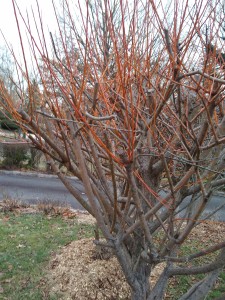 What with all the seasonal decorations, scarlet poinsettias, and other adornments, we are all seeing red at this time of the year. But what about the cold, dark days that still loom ahead? You have to be a real optimist to look out at the winter landscape and see anything other than shades of brown, gray, long-faded green, and dirty white. I was thrilled when I saw a spot of red in one of my front beds and raced out to see what it was, only to find that it was a piece of windswept trash that escaped the neighbors’ can.
What with all the seasonal decorations, scarlet poinsettias, and other adornments, we are all seeing red at this time of the year. But what about the cold, dark days that still loom ahead? You have to be a real optimist to look out at the winter landscape and see anything other than shades of brown, gray, long-faded green, and dirty white. I was thrilled when I saw a spot of red in one of my front beds and raced out to see what it was, only to find that it was a piece of windswept trash that escaped the neighbors’ can.
Of course, we gardeners are better equipped than many people to “keep calm and carry on.” That is why God created plant catalogs. However, you can also do something about the drab winter landscape—at least for next winter—by investing in shrubs with red stems or branches. In the absence of leaves, these bright stems glow in the winter light.
The plants in question are members of two genera: Cornus or dogwood, and Salix or willow. All are reliable, unfussy growers that are somewhat adaptable to the conditions in most gardens.
My front yard is home to Salix alba subsp. vitellina ‘Britzensis’, otherwise known as coral bark willow. As the name suggests, this is a subspecies of white willow, but its claim to fame is that new growth emerges brilliant red. I grow mine as a small tree, because I like having room underneath for perennials and annuals. It can also be grown as a multi-stemmed shrub.
If you consult reference sources about ‘Britzensis’, you are likely to be alarmed, as at least one reliable source says that it can grow between 15 and 80 feet tall, while achieving 10 to 50 feet in width. I have never seen one anywhere near that big. What the information tells you is that the variety grows vigorously, especially in the damp circumstances it favors. It is a willow, after all, and like its relatives, grows so readily that it will root virtually overnight in a glass of water.
That said, all you have to do is prune regularly, a job that is not even that hard. My tree-form ‘Britzensis’ is probably seven feet tall and four feet wide at the crown. By pruning it hard twice a year, I control its rampant tendencies and assure myself a large amount of new growth, which is the only part of the plant that is red. Looking out the window now, I see ‘Britzensis’ aflame in the light of a late December afternoon.
The red-stemmed dogwoods hail from three species; Cornus sericea or red osier dogwood; Cornus alba, also known as white dogwood; and Cornus sanguinea or bloodtwig dogwood.
With its clusters of white spring flowers, abundant pinkish-white fruits, and flaming winter stems, Cornus sericea ‘Cardinal’ provides near year-round interest. It is a multi-stemmed deciduous shrub that thrives in either sun or light shade, and will even work in boggy soil. Though it is vigorous, it has somewhat better manners that Salix ‘Britzensis’, growing only six to nine feet tall and eight to 12 feet wide. It can be kept smaller with judicious pruning, which also produces more stems. As with other red-twigged specimens, the color comes with new growth and shows best in winter, after the leaves have departed.
Developed at the University of Minnesota, ‘Cardinal’ is descended from a native species. It is perfect for informal hedges, rain gardens, habitat landscapes, or use as a stunning specimen.
Bloodtwig dogwood’ is a rather barbarous name for a lovely plant of European origin. The ‘Midwinter Fire’ variety of Cornus sanguinea features small white spring flowers, golden fall leaves and black berries that will attract birds and wildlife. Its claim to fame, however, is golden winter stems topped by bright red twigs—a combination certain to stand out even when earth, sky and everything in between are the same shade of midwinter gray and the indoor environment may well carry the lingering odor of wet wool or wet dog.
Tatarian dogwood, or Cornus alba, is native to Asia, and is normally grown as a multi-stemmed shrub. Comfortable in smaller spaces, the red-twigged ‘Sibirica’ variety grows only four to seven feet tall and three to five feet wide. The new growth flames red in winter, but, the plant offers four seasons of interest. Showy white flower clusters or cymes appear in the spring, followed by white berries or drupes that sometimes have a hint of blue. The elongated ovoid leaves turn red-purple in autumn, before ceding the spotlight to the bright red stem growth. As with other red-twigged varieties, the harder ‘Sibirica’ is pruned, the more red stems appear during winter’s dark days.
Whether you grow Salix ‘Britzensis’ or one of the red-twigged dogwoods, a sunny or lightly shaded site with consistent moisture will make your chosen plant happiest. All have a tendency to increase in size by suckering, which if fine if you are filling in a hedge or planting a semi-naturalistic landscape. If you need to contain the chosen plant’s size, remove the suckers as they emerge. It is a small price to pay for relief from the winter garden doldrums.
